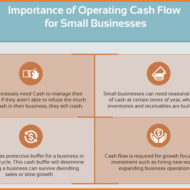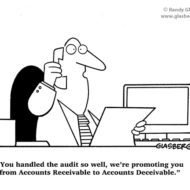Posted by Managementguru in Financial Accounting, Financial Management, How To
on Dec 19th, 2018 | 0 comments

If you own a small business, then you’re probably no stranger to cash flow issues. In fact, 21% of businesses claim that cash flow problems were significant issues, potentially leading to closing down. One of the best ways business owners can ensure success is by carefully managing cash flow. Because no matter how great your business plan is, your business won’t survive if you run out of money. What Causes Cash Flow Problems? Before you can get a handle of your cash flow issues, you have to understand why they occur. Here are three common reasons why cash flow problems may arise: Unnecessary Spending Many business owners have head the old adage that you have to spend money to make money. Unfortunately, this belief has caused many ambitious business owners to overspend. Not all business expenses equally as important to your operations. Consider the cost-benefit of each expense. Overestimating Future Earnings Optimism is a great trait but it needs to be paired with a healthy dose of objectivity. It’s important to forecast your sales based on previous earnings and data. By not counting on future earnings that may never show up, you can prevent overspending. Inconsistent Sales Some businesses have occasional spikes in sales followed by months where they sell next to nothing. Trends like these cause problems with budgeting and makes it difficult for business owners to make operational decisions, often choosing to survive off of their “good” months. Get started with Flexible Funding today! Flexible Funding provides payroll-funding solutions in addition to back and front office support services as well. Flexible Funding works with staffing companies to implement the right staffing-industry software solutions for each client’s unique needs to create the best solutions and to save you time and money -from off-the-shelf accounting packages like QuickBooks and Sage 50 Accounting to in-house custom-built financial accounting software tools. Whether you are a start-up or an established staffing agency looking for best business practices, Flexible Funding will find the right solution for you– from payroll and invoice processing to W-2 preparation and filing, background checks, custom reporting, and so much more. Tips for Avoiding Cash Flow Problems Cash flow problems are a reality for nearly all business owners but there are ways to manage them. Here are five ways to mitigate your cash flow issues: 1) Take Out a Short-Term or P2P Business Loan A short-term business loan can provide the capital you need to run your business and pay for any expense, from inventory to office furniture. Short-term business loans have a high rate of approval even for businesses with limited credit history. You’ll receive the money faster than you would if you took out a traditional bank loan, which can be extremely helpful if you have immediate needs. Sometimes the application process can take as little as 24 hours. One of the first places to check for business loans as a business owner would be Small Business Administration. Or, if you prefer to bypass the government, you can try a peer-to-peer business loan. These loans are funded by individual investors through a lending platform. However, these loans usually require more frequent payments, and you will likely end up with a higher interest rate. 2) Use a Working Capital Loan Working capital loans can give you the cash flow to cover crucial operational costs like rent and payroll. This gives you the flexibility to invest in your company’s growth and still cover day-to-day expenses. Unlike other business loans, working capital loans don’t require that you state your reasons for taking out the loan. However, you will have to repay this loan quickly and your loan may have a...

Posted by Managementguru in Financial Accounting
on Feb 24th, 2015 | 0 comments

What are known as Final Accounts? Trading, profit & loss account and balance sheet, all these three together, are called as final accounts. Final result of trading is known through Profit and Loss Account. Financial position is reflected by Balance Sheet. These are, usually, prepared at the close of the year hence known as final accounts. They serve the ultimate purpose of keeping accounts. Their purpose is to investigate the consequence of various incomes and expenses during the year and the resulting profit or loss. 1. Trading and Profit and Loss A/c is prepared to find out Profit or Loss. 2. Balance Sheet is prepared to find out financial position of a concern. Trading Account Trading refers buying and selling of goods. Trading A/c shows the result of buying and selling of goods. This account is prepared to find out the difference between the Selling prices and Cost price. Profit and Loss Account Trading account discloses Gross Profit or Gross Loss. Gross Profit is transferred to credit side of Profit and Loss A/c. Gross Loss is transferred to debit side of the Profit Loss Account. Thus Profit and Loss A/c is commenced. This Profit & Loss A/c reveals Net Profit or Net loss at a given time of accounting year. Trading Profit And Loss CMD from knoxbusiness Balance Sheet Trading A/c and Profit & Loss A/c reveals G.P. or G.L and N.P or N.L respectively; besides the Proprietor wants i. To know the total Assets invested in business ii. To know the Position of owner’s equity iii. To know the liabilities of business. Definition of Balance Sheet The Word ‘Balance Sheet’ is defined as “a Statement which sets out the Assets and Liabilities of a business firm and which serves to ascertain the financial position of the same on any particular date.” On the left hand side of this statement, the liabilities and capital are shown. On the right hand side, all the assets are shown. Therefore the two sides of the Balance sheet must always be equal. Capital arrives Assets exceeds the liabilities. BUY “ACCOUNTING CONVENTIONS AND CONCEPTS” OBJECTIVES OF BALANCE SHEET: 1. It shows accurate financial position of a firm. 2. It is a gist of various transactions at a given period. 3. It clearly indicates, whether the firm has sufficient assents to repay its liabilities. 4. The accuracy of final accounts is verified by this statement 5. It shows the profit or Loss arrived through Profit & Loss A/c. PREPARATION OF FINAL ACCOUNTS Preparation of final account is the last stage of the accounting cycle. The basic objective of every firm maintaining the book of accounts is to find out the profit or loss in their business at the end of the year. Every businessman wishes to find out the financial position of his business firm as a whole during the particular period. In order to accomplish the objectives for the firm, it is essential to prepare final accounts which include Trading, Profit and Loss Account and Balance Sheet. It is mandatory that final accounts have to be prepared, every year, in every business. Trading and profit & loss accounts are prepared, after all the accounts have been completely written and trial balance is extracted. Before preparing final accounts, it becomes obligatory to scritinize whether all the expenses and incomes for the year for which accounts are prepared have been duly provided for and included in the accounts. Form of Final Accounts: There is a standard format of final accounts only in the case of a limited company. There is no fixed prescribed format of financial accounts in the case of a proprietary concern and partnership...




